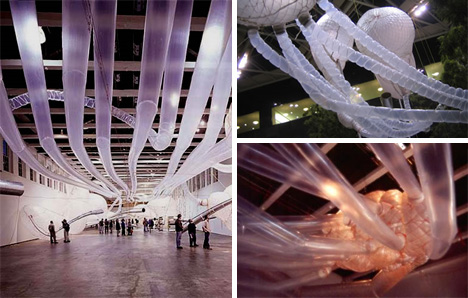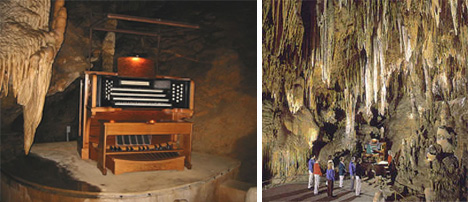Most music lovers can agree that music doesn’t always follow the rules. Some of the most beautiful melodies have come from artists who chose to do their own thing despite conventional wisdom. The same is true for artists who create new instruments. Where would modern music be without the “crazy” instruments and techniques invented and modified over the years? These instruments are among the most innovative, the most creative, and the most bizarre out there.
Uberorgan
(images via: Oddmusic)
When Los Angeles artist Tim Hawkinson toured around the country with a massive indoor sculpture, he caused big reactions from just about everyone who saw it. Many of them wondered just what it was, and they can be forgiven for not understanding immediately. After all, the 300-foot long sculpture was comprised largely of 13 bus-sized inflated bags and was simultaneously organic and alien. But when it started playing, it was obvious: the Uberorgan was a massive musical instrument. The entire assembly looked like massive ethereal jellyfish suspended in mid-air, but operated like the giant lovechild of a bagpipe and a pipe organ. A visual sensor “read” notes from a scrolling 200-foot-long roll of Mylar to entertain viewers with a score he composed just for the Uberorgan.
The Great Stalacpipe Organ
(images via: Oddmusic)
The world’s largest instrument resides in a cave in Virginia, and the music it produces is both earthy and otherworldly. The Great Stalacpipe Organ was created in 1954 after Pentagon scientist Leland W. Sprinkle noticed that the stalactites in Luray Caverns produced resonating notes upon being struck. He spent three years tuning stalactites to precise pitches – with sandpaper. He then wired rubber mallets to strike the stalactites when corresponding keys are depressed on the organ’s keyboard. The organ still plays today for visitors to Luray Caverns.
The Nano Guitar
(image via: Cornell)
If you thought playing a ukulele was hard, try plucking this tiny guitar. It’s a six-string guitar made of crystalline silicon, and it’s no bigger than a single cell. Each string is 50 nanometers wide: the width of 100 atoms. Researchers at Cornell University created it in 1997 to showcase emerging technology for manufacturing a new generation of electronics. Though it can technically be played (if you happen to have access to an atomic force microscope), the 10 micrometer-long instrument would only resonate at inaudible frequencies.
Croatia’s Sea Organ
(images via: Oddmusic)
Visitors to the sea front in Zadar, Croatia used to be greeted by grim, ugly concrete walls. But since the public unveiling of the Sea Organ in 2005, visitors have been able to visit the sea front to enjoy the music of nature. The Sea Organ is a musical instrument that consists of 35 musical tubes with openings on the above concrete stairs. Movement of the sea’s waves pushes air through the openings, creating incredible chords and dissonant tunes. Similar instruments exist in San Francisco and Blackpool, but Zadar’s version can be heard more consistently and has done wonders for the tourist trade in the area.
The Viennese Vegetable Orchestra
(images via: Vienna Vegetable Orchestra)
Thought to be the only orchestra in the world using nothing more than vegetable instruments to make music, the Vienna Vegetable Orchestra has been performing around the world since its formation in 1998. Its members carve, cut and tweak fresh produce to create a multisensory musical experience. Their instruments are made fresh right before every performance, and after they wow audiences with their musical prowess their staff cook makes a delicious vegetable soup from some of the vegetables – hopefully not the parts the musicians have been blowing into. Just don’t ask the orchestra members if they’re all vegetarians; they’re tired of hearing that question over and over.






